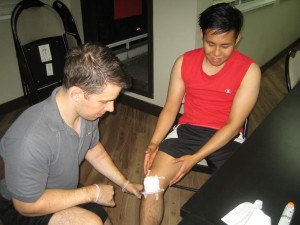
Every now and then, individuals can get scrapes or cuts even during daily activities at home such as preparing food particularly slicing vegetables or minor trips or falls. As for a puncture wound, it occurs if you stepped on a pointed object. Bites from animals or humans are prone to infection, thus if it is too deep that resulted to bleeding, it is best to seek medical attention right away. If you or a family member gets a cut, scrape or puncture (example: knife wound), it is important that you know how to deliver the appropriate first aid care. To learn via hands-on training on how to provide care for scrapes, wounds and punctures enrol in St Mark James first aid training.
Apply Clean Bandages
The first step on first aid care for cuts and scrapes is to stop the bleeding. Majority of wounds typically respond to the application of direct pressure using a bandage or clean cloth. You have to apply pressure continuously for about 10-20 minutes. In case this will not stop the bleeding or it continues to bleed profusely, it is best to seeking medical assistance.
Clean the Wound
The next step is to clean the wound using soap and water. Any foreign material or debris present in the wound should be removed in order to prevent infection. You can utilize tweezers to remove the foreign material for the edges of the wound, but avoid digging into the wound since it can drive in bacteria deep into the subcutaneous area. The wound can be scrubbed gently using a washcloth in order to remove any debris or dirt. You can use products such as povidone-iodine (Betadine) or hydrogen peroxide to clean the wound initially, but it can impede the healing process if utilized on a long-term basis.
Cover the Wound
Once you have properly cleaned the wound, the wound should be covered with a bandage in order to prevent dirt from entering the wound or infection from developing. It is important to apply an antibiotic ointment such as Neosporin or Bacitracin to prevent infection as well as keeping the wound moist.
Ongoing Care
Ongoing care to the wound is also vital as part of the first aid care. You have to wash the area in a gentle manner with soap and water three times a day. It should be followed with the application of the antibiotic ointment and cover it with fresh bandages. If the bandage becomes wet or dirty, you have to change it with new ones.
Watch Out for Infection
Now that the cut or scrape has been given the appropriate first aid care, do not forget to be on the lookout for signs of infection. It is best to consult your doctor if the wound does not heal or if there is drainage, redness, swelling and warmth on the area surrounding the wound. For puncture wounds, you have to see your doctor if it is deep, located in your foot, human or animal bite and if it has been contaminated by soil or saliva.
